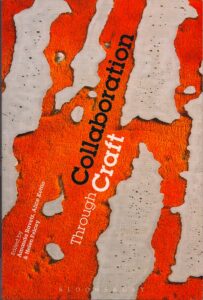SDA Book Club: “Collaboration Through Craft” reviewed by Faith Hagenhofer
April 1, 2022

Collaboration Through Craft edited by Amanda Ravetz, Alice Kettle, and Helen Felcey
One thing that signals success in a work (or collection of works, as this is) is the degree to which it sends me to its footnotes and source materials. In other words, does it excite me to look further? This collection of sixteen essays, most of which deal with specific and vastly different projects that highlight both craft and collaboration, does just that. I find that, while each example is different, they raise similar questions for me: when is work collaborative vs cross disciplinary? At the end of a collaborative event who is responsible for what? If the result is pre-imagined or predetermined might the title have been “Craft through Collaboration”? A number of the essays are about projects that I might argue fit there. Likewise, a few of the works written might be in a collection called Collaboration and Craft, speaking of shared ground or assumptions. Could this be one in a series of books that look at collaboration through other lenses, such as medicine, food or investing? Bringing collaboration and craft together. An early set of definitions (p. 1) in the introduction are as follows:
- collaboration is “workmanship-like exchanges between individuals and across disciplinary boundaries that are freely entered into and that through joint endeavor leave one or both sides significantly changed.”
- craft “can occur in any field at all, but crucially involves risk and contingency” and “is about using skilled attention to enter life’s generative, relational, temporal, improvisatory flow.”
A few authors refer to Glenn Adamson’s definition of craft as “a way of thinking through practices of all kinds” (quoting his 2007 book Thinking Through Craft). While these essays are not necessarily focusing on materials, they are also not discussions of those traditional crafts that require a team—glass blowing for example—but more of deliberate art practices that foreground multiple peoples’ involvement and skills. And yet, tacit knowledge (skills, ideas and experiences that are possessed by people but are not codified and may not necessarily be easily expressed) germane to each essay’s project is a given here.
I found myself asking of the many projects examples, “which part of this is craft?” or “where is the collaboration?” Some chapters offer insight: collaboration is like a conversation; collaboration is the path not the place; collaboration is an entanglement, not a network; collaboration is a holding place for many ideas. I really appreciate Helen Carnac’s “There may be some perception that something will get lost from an individual’s voice in collaborative practice, but perhaps if there is a loss, it can leave room for something new” (p. 41). Unique aspects of how the participants viewed their roles as collaborators were explicit while their capacities as makers were interrogated much less. The final essay asks: “What is it about collaboration that we and others value so much?” and has this to say: collaboration allows us to feel “dispersed creativity” and a power derived from combination as it “evokes the difficulties as well as the pleasures of working with others”.
–Faith Hagenhofer
- Publisher: Bloomsbury (buy it here)
- Date: November 2013
- ISBN: 9780857853912
If you’ve read this book, leave a comment and let us know what you think!
Do you have a recommendation for a recent fiber-related book you think should be included in SDA’s Book Club? Email SDA’s Managing Editor, Lauren Sinner, to let her know!


